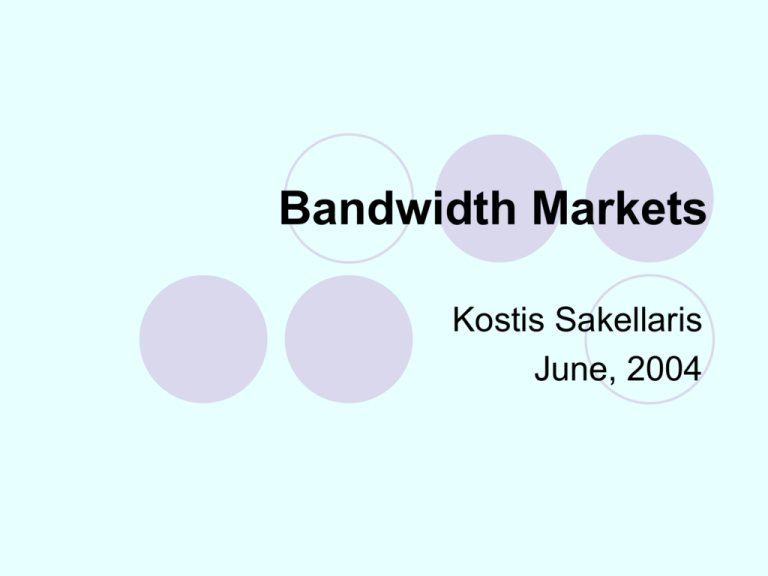Presentation
advertisement

Bandwidth Markets Kostis Sakellaris June, 2004 1. The Emergence of Bandwidth Markets In the 1990s there were shortages of global bandwidth foreseen Internet traffic was said to be doubling every three months The bandwidth markets presented an effective and efficient mechanism for matching the needs of users and suppliers 1. … and their downfall. No shortage of bandwidth: capital expenditure on fiber infrastructure far exceeded actual demand Internet traffic grew closer to 100% per year (instead of 1000%). Failure of the highest profile bandwidth trader, Enron. 1. … and their downfall. Telecommunications sector “depression” Deregulation has opened the market to dozens of new operators Excess capacity is flooding the market Competition has heightened dramatically Revenues have plummeted Where “dynamic” was once used to describe the international bandwidth market, “volatile” seems to be the current adjective of choice 2. Bandwidth Trading Corrosive effect of demand/supply mismatch on bandwidth pricing. Annual STM-1 lease prices on major European routes have fallen by 85 to 90 percent from 1999 to 2002. While the decline of prices has been consistent across the sector, prices themselves vary widely among carriers. On major routes, the highest price was often four times the lowest price 2. Bandwidth Trading Currently, bandwidth considered: trading can be A market for surplus inventory Distressed sales market Bandwidth trading permits the participation in a surplus inventory market by re-sellers and intermediaries. 2. Bandwidth Trading Typical Contract Structures: IRUs (Indefeasible Right of Use) Lease Contracts. 2. Bandwidth Trading Lease Contracts Initially lease agreements were no less than five years and typically limited to 10 years. More recently in what is now a clearly distressed, or ‘buyers’ market, shorter term leases have become available. 2. Bandwidth Trading IRUs IRU contracts are pre paid leases Enabled buyers to treat the asset purchased as a fixed asset until late 1999. Majority of the capital sum is paid in advance with a smaller operation and maintenance charge paid annually. IRU durations available in the market range between 10 to 25 years. 2. Bandwidth Trading Traditionally, bandwidth negotiations are: Bilateral Time consuming Require a business relationship Lack of price information Fully specified price, quality, minimum usage and performance 3. Bandwidth as a Commodity Deregulation of the telecommunications industry has changed the landscape. Existing bilateral nature of buyer-seller relationship is inefficient and impractical. Long provisioning times compared to the speed of business, Uncertain traffic profiles Necessity of ‘global coverage’ 3. Bandwidth as a Commodity Special considerations: Bandwidth capacity is generic with the exception of Quality of Service. Bandwidth is not storable Geographical arbitrage Integration of voice/data traffic Also: liquidity, connectivity. standardization and 4. Arbitrage Issues At least four arbitrage opportunities in bandwidth trading: Temporal arbitrage Product arbitrage Geographical arbitrage Distributional arbitrage Theoretically arbitrage can be eliminated by appropriate market design. 4. Arbitrage Issues Example: geographical arbitrage Monthly fee of a one-year DS-3 contract between NY and Prague offered at $70,000. Cost connecting NY-London is $18,000 and London-Prague is $28,000. Therefore buying the two segments will incur a cost of just $46,000. 4. Arbitrage Issues Example: geographical arbitrage 5. Bandwidth Risk Management Market Participants see as the most important benefit from bandwidth trading the development of bandwidth derivatives and their application in: Risk Management Speculation Arbitrage 5. Bandwidth Risk Management Risk Management Lock-in the future price of bandwidth stabilising future revenue streams Cap possible losses in case of price fluctuations. Deconstruct risks in order to bear only the acceptable risk desired and offload all other risk in the market. 5. Bandwidth Risk Management Real Options Can be defined as opportunities to respond to changed circumstances of a project by management. These opportunities are rights, but not obligations, to take some action in the future. Aim to quantify management’s flexibility. 6. Bandwidth Exchange Neutrality Anonymity Speed Coverage Financial Safety Nets Quality of Service Management Standard Contract 6. Bandwidth Exchange Benefits for sellers: Offer broader range of termination services Offer termination services at or below marginal cost for short term periods Arbitrage pricing and capacity More manageable cash-flows Plan network utilisation in a real-time environment 6. Bandwidth Exchange Benefits for buyers: Acquire termination services at lower price than the bilateral agreements Limit market exposure Managing cash-flows Provision of management tools in terms of the routing table 7. Existing Markets The survivors are profiting: Arbinet-The exchange - 298 Members in 2003 (up from 135 in 2001) - 7.9 billion minutes in 2003 (+57% 2002) Band-X - 20 carriers in 2002 - 0.5 billion minutes in 2002 7. Existing Markets Arbinet: Services offered include: Marketplace for voice minutes (three products) Marketplace for data (three products) SwitchAxcess, for optimized routing RapidClear, for accelerated settlement services Information products 7. Existing Markets Arbinet: It can minimize or eliminate risks like: Burying Codes: Argentina - Each city assigned its own mobile codes - Buried seven digits in phone number so most carrier routing software is unable to read them. Geographical Arbitrage 7. Existing Markets Band-X Case Study: Real Data Services Ltd (London-based ISP) Became facilities-based carrier: Cut down middle-man Virtually no capital expenditure No additional operations or engineering resources With benefits of BT interconnect rates 8. Bandwidth Markets Outlook Through bandwidth trading carriers can: reduce their costs of doing business restore some of the profit margin lost due to increased competition, and apply risk management techniques. Still, bandwidth trading in an elementary stage. 8. Bandwidth Markets Outlook Future of bandwidth trading is not bright, but still it has potential. It is not impossible that it could evolve to being a primary or major secondary market. Whether this potential is realised depends upon the state of competitiveness in telecommunications markets over the next few years.





